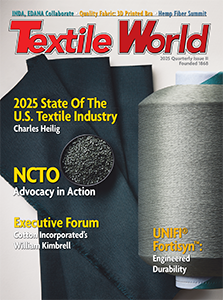dander and other allergens. According to www.medicinenet.com, an online healthcare resource produced by a network of US Board-certified physicians, more than 90 percent of asthma patients exhibit symptoms at night, commonly between midnight and 8:00 a.m. Among the guidelines provided by the National Institute of Allergy and Infectious Diseases to make the bedroom dust-free is the recommendation to envelop the bed mattress and box springs in a zippered encasement that serves as a two-way barrier — preventing allergens that have settled into those articles from passing through to plague the sleeper, as well as keeping ambient allergens in the room out of the mattress or
springs.The key attribute of such an encasement is a pore size small enough to prevent the transmission of the allergen particles — which could be as small as 1 micron but generally range from 2 to 30 microns with an average of 5 to 6 microns for pet dander and 6 to 10 microns for dust
mite fecal matter. Another important consideration is moisture vapor transmission, which affects comfort levels.
CleanRest zippered mattress and pillow encasements have been certified asthma friendly® for their level of efficacy in preventing the transmission of allergens.
CleanBrands LLC, East Providence, R.I., offers a line of zippered pillow and mattress encasements that it claims provide maximum allergen protection as well as comfort. Branded CleanRest™, the covers are made with a breathable, coated fabric with much smaller pore sizes than those exhibited in typical breathable anti-allergen encasements available on the market.
The company was founded in 2006 by Gary Goldberg, parent of a child afflicted with night-time asthma and a third-generation veteran of the textile industry whose experience includes involvement in the development and manufacture of products such as military protective clothing and high-performance athleticwear. In his quest to provide his son with a comfortable, allergen-free sleep environment, Goldberg became frustrated with the performance of conventional encasements.
Vinyl products kept the allergens at bay but did not allow moisture vapor to pass through, and breathable products did not block the transmission of all the allergens. So Goldberg put his own knowledge and experience to work and went about engineering a fabric system, based on technology used in military protective clothing, that would provide both the protection and the comfort required.
The result was MicronOne™ — a microfiber polyester fabric with a breathable urethane-based coating on the underside, and with pore sizes no larger than 1 micron and a mean pore size of 0.125 microns. The fabric is the basis of the CleanRest encasements, which are embossed with the CleanRest logo and the brand’s Protect Your Sleep™ tagline. Consumers may purchase the encasements online at www.cleanrest.com and at retail stores currently including 850 Bed Bath & Beyond stores nationwide, as well as Target stores in Southern California and the Atlanta area. The product line is the first to receive asthma friendly® certification from Allergy Standards Ltd. in
partnership with the Asthma and Allergy Foundation of America.
Besides providing allergy sufferers with breathable protection from particles that might have settled into the bedding — there may be millions of dust mites in a single mattress — CleanRest
products are water- and stainproof, thus also providing an incontinence barrier for the mattress and pillow. They also are durable; in testing, they have maintained their high level of moisture vapor transmission, hydrostatic resistance and tear resistance after laundering 100 times at 150°F, and they carry a lifetime guarantee.
Speaking about the place of sleep in a healthy lifestyle, Goldberg said: “Sleep is being defined by comfort, but we think cleanliness is another component of sleep. It’s our opinion that uninterrupted, clean sleep is equally as important as diet and exercise, and there are many long-term health studies that talk about sleep debt as it affects people: for example, increased heart disease, obesity, diabetes, low cognitive skills and poor academic performance.”
Goldberg sees the CleanRest products as medical devices and markets them to physicians in much the same way that pharmaceutical companies market their products. “We have a group of preferred physicians that we send information to, and in turn give them coupons to drive sales back to Bed Bath & Beyond and Target stores, so it’s like a referral where we’re trying to get doctors to prescribe our product,” he explained.
Looking ahead to future product development, Goldberg is considering enhancing CleanRest in order to offer a top-tier product line for high-end department and specialty stores, and possibly later also offering a basic line for lower-priced retailers. All would provide the same level of
allergen protection. He also is considering incorporating antimicrobial protection into the product. Goldberg also is talking to some major mattress companies about integrating MicronOne into the actual mattress before the allergens have a chance to settle in. Upholstered furniture is another application where he sees potential.
“The mattress space is where the consumer spends the most time in the house,” he said. “Every home in America is infested with dust mites except in high-altitude and very arid locations — the higher the humidity level, typically, the higher the dust mite level. The second place where the consumer spends the most amount of time is the family room, so if you’re not lying on your bed, you’re lying on your couch, and that couch is equally as infested with dust mites as the mattress.”
The MicronOne fabrics are produced in South Korea and shipped to China for making up into the CleanRest encasements. Goldberg does not own these links in the supply chain, but, he said, “We have good partners and employees that I talk to in both locations,” who help to ensure product
quality.
For more information about MicronOne™ and CleanRest™, contact (877) 215-REST; ggoldberg@cleanrest.com; www.cleanrest.com.
August 14, 2007




